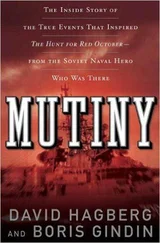He doesn’t have time to say any more.
The third blast is more powerful than those that came before it, and it feels like the walls are about to come crashing down. Plaster, splinters and dust swirl through the air, and Ann-Marie starts screaming. No one tries to stop her.
Tavernier has had enough.
“Follow me!” he shouts, breaking into a run.
He is still holding his phone to his ear, and he rushes over to the opposite door, toward the stairwell.
Finally, he has become the leader he’s always wanted to be. They follow him, all of them, without any hesitation. The moment they make it into the stairwell, his phone loses the signal, but Tavernier continues—the stairs will take them down to the security doors outside the vault—and the others follow.
I’ll create a new secure position, he thinks. Because real leaders make smart decisions in difficult situations.
5:32 a.m.
This time, it takes a while for the dust to settle.
Maloof’s ears are ringing when he steps out of the storeroom. The relief he feels when he sees the battered door is indescribable. The gap is more than wide enough. Nordgren is already moving past him with one of the crowbars. He grabs the other.
With the larger of the two crowbars, they manage to force the door open. It falls into Counting with a thud.
Sami already has his gun raised, and he enters the room ahead of the others. He scrapes his hand on the half-destroyed wall on his way in.
He doesn’t expect there to be any staff left in the room, the bank world always instructs its employees to evacuate the premises as soon as they can. But nothing is guaranteed.
With his machine gun at hip level, he searches the room. It’s empty.
—
Maloof is close behind him. He glances at his watch. They’ve already taken over five minutes, and they still haven’t seen the money.
He starts the angle grinder. He does it by hand. It’s gasoline driven, so it’s a bit like starting an outboard motor or a lawnmower from the sixties. The engine starts with a loud roar. He moves over to the cages where the notes have been stashed and uses the grinder to cut the locks. A shower of sparks cascades beautifully to the floor. The smell of two-stroke gas fills the room.
Nordgren realizes that the staff has managed to lock everything in the cages. Yet more proof of how long it took them to get in. He banishes the thought. He doesn’t want to think about how many police officers are currently waiting outside.
As Maloof cuts open the cages, Nordgren and Sami fetch the mailbags.
The money is bundled up in red plastic boxes. They search for the 500-kronor notes and throw the boxes containing the 100- and 20-kronor notes to the floor.
Maloof moves on to the next cage. He puts down the angle grinder without turning it off, and it spins on the floor as though it had a life of its own. He tests the cage door. It won’t open. He grabs the angle grinder and cuts through the last bit.
The second cage contains the larger denominations.
They get to work.
As soon as one bag is full, they drag it out to the next room, into the storeroom by the reinforced glass window, and then throw it down to the balcony on the fifth floor.
All this takes time.
Each of them knows that they can’t spend much longer inside the building, but they continue anyway. They’ve been in a rush since they first stepped out of the helicopter, but they now know that they’re in an extreme rush. Once it looks like there’s no more room for mailbags on the little balcony on the fifth floor, they decide that they’re done.
5:35 a.m.
Task Force Leader Caroline Thurn climbs into the police van serving as the liaison center parked outside the Statoil station directly opposite the G4S cash depot. The station is on a slight elevation, which means it has a good view of its surroundings. The blue flashing lights from the patrol cars in the distance lend a cinematic quality to the scene. The sound of the robbers’ helicopter adds to that. Thurn had spotted it earlier, but it now seems to have disappeared into the dark night sky.
She has two options: either send people into the building immediately, risking shots being fired and a possible hostage situation, or wait until the robbers are back in their helicopter and attempting to make their getaway. She has a few more minutes to make her decision.
There are two uniformed police officers sitting in the front of the van, and several other people in the back. One of them is in plainclothes, and he has a laptop computer open in front of him. On the screen, Thurn catches sight of the green, pixelated images typical of live CCTV cameras.
“Who is that?” Thurn asks the nearest police officer.
“No idea.”
“What’s a plainclothes officer doing here?”
“Ask Månsson,” the officer suggests, referring her to the commanding officer.
The officer crouches back into the front seat. Thurn moves toward the back of the van and the stranger with the computer. The man seems to be in his early middle age, and he has a ruddy complexion and thick glasses.
“I’m Caroline Thurn,” she introduces herself. “I’m taking over command out here. Who are you?”
The man looks up at the tall police inspector and nods.
“Palle Lindahl,” he replies. “G4S security chief.”
Lindahl pulls out a business card and hands it to Thurn.
“You got here very quickly,” Thurn comments.
“I live just over there,” Lindahl replies.
He points out of the window and then continues:
“The manager in Counting, Claude Tavernier, raised the alarm with the on-duty guard. That was”—Lindahl checks the time on his phone—“twenty minutes ago. The guard called Skövde, which is where we have our control center. Skövde called me, as they’re meant to. I pulled on some trousers and… walked over. You lot were already here.”
Thurn nods. “Is there a risk of a hostage situation?”
That’s her most pressing concern.
“There’s no need to speculate,” the security chief replies, turning his computer so that she can see the screen.
On it, two men dressed in black are standing in front of what look like tall, bar-covered cages. They are lifting boxes out of the cages and then dumping bundles of notes into fabric bags. One of the men has an automatic weapon, probably a Kalashnikov, hanging from a strap over his shoulder.
“We have over eighty CCTV cameras in the building,” Security Chief Lindahl explains, “I can bring them all up on screen.”
“Impressive.” Thurn nods approvingly. “But sadly that doesn’t help.”
“The cameras aren’t meant to prevent crimes,” Palle Lindahl replies, sounding offended. “No number of cameras or vaults will keep skilled criminals away for particularly long. Our reasoning is that the perimeter security should stand up to attack for fifteen minutes. That should be enough time.”
“Enough time for what?” the inspector asks.
“Enough time for the police to get here. That fifteen minutes has passed, and you’re here. I can open and lock the doors and elevators throughout the entire building from my computer. You have a lot of people here. I can lead you up to the robbers, if you want.”
Thurn nods thoughtfully and peers out the police van window.
The many uniformed officers are standing outside their blue-twinkling cars, talking to one another in small groups. The reason none of them seem to be hurrying, or expecting orders of any kind, is that none of these officers have been trained for a situation like this. These were men and women who could chase down vandals and muggers, who could keep drunks away from public places, overpower men who abused their wives in apartments in the southern suburbs and in the best case also hit the target during their annual shooting exam. But they had no experience tackling international organized crime.
Читать дальше












